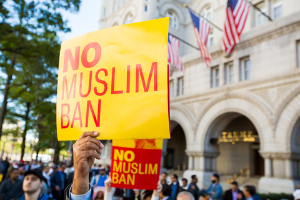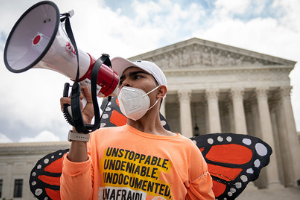Texas’ Judge Shopping Undermines Public Interest and the Future of Public Policy
THE TORCH: CONTENTS By Max Wolson
October 4, 2022
Driven by ambitions for higher office at any expense, Texas’ governor and attorney general have challenged virtually every action taken by the Biden administration. Texas is particularly committed to stymieing any attempt to make the immigration system more just and humane. But immigration is not the only target. Texas’ numerous lawsuits against the administration have also attacked everything from abortion access to environmental protections.
Texas’ litigation tactics are as awful as its motives. In each case Texas has filed within its state, Texas has engaged in “judge shopping,” a practice of manipulating court rules to all-but hand-pick which district judges will initially hear the cases they bring. Texas has done so with a clear goal: prevent any judges appointed by Democrats from hearing these cases and ensure an outcome in Republicans’ favor. That manipulation has worked; of the 20 politically motivated lawsuits Texas has filed in federal court, a Democrat-appointed judge has heard only one case.
In an ideal world, the judiciary stands apart from politics. But, by hand-picking only judges appointed by Republicans, Texas takes a huge step away from that ideal. Texas ensures that each decision it obtains is tainted by politics. The result is a minority of states obstructing national policy in front of only a handful of cherry-picked judges appointed by a single political party.
While judge shopping is harmful, the problem is easily solvable. The future of justice, policymaking, and democracy in this country depends on it.
Zooming Out: How Court Cases Are Assigned to A Trial Judge
The federal court system is comprised of 94 judicial districts within which most new cases are filed. Each state has between one and four judicial districts. Judicial districts range in size from a single city to an entire state.
Districts can be vast; for example, the District of Alaska spans the State’s entire 665,400 square miles. As a result, many districts are further subdivided into “divisions.” Federal law establishes in which district a new case must be filed but leaves it to the individual courts to decide how to divide work among divisions.
Texas has four judicial districts: the Northern, Eastern, Southern, and Western Districts of Texas. Each district is further divided into divisions. Many of these divisions contain three or fewer judges, each assigned a set percentage of new cases. And many of those one-to-three-judge divisions assign between 95 and 100 percent of new cases to judges appointed by Republican presidents. In other words, by choosing a specific court for a new case, a litigator can virtually guarantee that a Republican-appointed judge will hear their case, and in some cases, which judge specifically will preside.
Texas has taken full advantage of the case-assignment system and filed every one of its 20 in-state cases in courts where Republican-appointed judges hear between 95 and 100 percent of cases, and in which three or fewer judges sit. Texas has filed eleven of those cases in courts where a single, Republican-appointed judge hears between 95 and 100 percent of cases. Put simply: Texas has made sure that it has never had more than a 1-in-20 chance of appearing before a Democrat-appointed judge. Texas has then used those cases to obtain unprecedented, nationwide orders barring numerous Biden administration policies from being implemented at the federal level.
Texas’ judge shopping is clearly intentional. The state does not file lawsuits in Austin, where its governor and attorney general are based, because half of cases there are assigned to a Democrat-appointed judge. Texas also avoids filing in most of its largest cities, including Dallas and El Paso, where Democrat-appointed judges sit. Texas’ only big city litigation has been filed in Fort Worth, a court with three Republican-appointed judges that lies 12 miles away from Dallas, a city with 11 judges from both political parties.
Immigration cases are Texas’ most flagrant examples of judge shopping. Texas has not filed any of its immigration-related lawsuits within 150 miles of the border because most courts near the border include Democrat-appointed judges. In fact, Texas has filed three immigration lawsuits in Amarillo, which is the furthest northern courthouse in the state, and assigns 95-percent of cases to a single, Trump-appointed judge.
Fighting Back to Restore Trust in the Courts
NILC is fighting back against Texas’ misconduct. Most recently, on September 19, 2022, NILC filed an amicus brief with the U. S. Supreme Court on behalf of renowned law professor Steve Vladeck and coauthored by attorneys at Jenner & Block. That case seeks to overturn Texas’ nationwide bars on the administration’s guidance about who to prioritize for immigration enforcement. Texas filed that lawsuit in Victoria, two hundred miles from the nearest point of the Mexico border where only a single Trump-appointed judges receives cases.
The brief shows how Texas is manipulating the judiciary and explains why that improper behavior undermines Texas’ arguments in two ways.
First, the brief explains that the courts have long interpreted the Constitution to forbid lawsuits over generalized political grievances. Texas’ manipulative conduct has been possible only because its claimed harms from Biden administration policies are not uniquely present in any of Texas’ locations (or Texas overall).
Second, the brief reiterates to the Court that orders like those granted by the trial court are only allowed if they are in the public interest. The brief explains how courts have regularly found that this type of manipulation of the courts harms faith in the independence of the judiciary and harms the public interest.
Texas is unlikely to change its conduct and a decision in the Supreme Court case won’t come until 2023. Until SCOTUS can make clear that Texas’ conduct is unacceptable, Congress and the Courts should take steps even sooner to block Texas’ behavior. Specifically, Congress could easily require that lawsuits against federal government policies be filed in the District of Columbia, where the federal government is located, and where judges appointed by both parties preside. Separately, the Texas federal courts could change their rules, requiring that lawsuits against nationwide federal government policies be randomly assigned among all the district’s judges and not just those in a specific division. Removing Texas’ ability to further politicize the courts will benefit all and go a long way toward restoring trust in our judiciary.
Max Wolson is a staff attorney at NILC.









